
Lasagna is a type of pasta, possibly one of the oldest types, made of very wide, flat sheets. Either term can refer to an Italian dish made of stacked layers of lasagna alternating with fillings such as ragù, béchamel sauce, vegetables, cheeses, and seasonings and spices. The dish may be topped with grated cheese, which becomes melted during baking. Typically cooked pasta is assembled with the other ingredients and then baked in an oven. The resulting baked pasta is cut into single-serving square or rectangular portions.
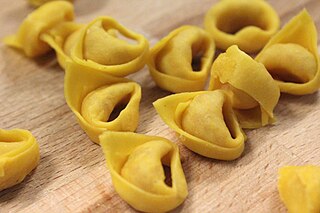
Tortellini are stuffed pasta originally from the Italian region of Emilia. Traditionally they are stuffed with a mix of meat, Parmesan cheese, egg and nutmeg and served in capon broth.
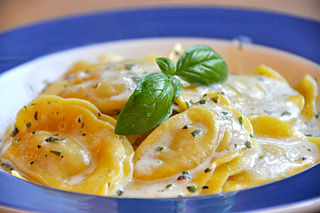
Ravioli are a type of stuffed pasta comprising a filling enveloped in thin pasta dough. Usually served in broth or with a sauce, they originated as a traditional food in Italian cuisine. Ravioli are commonly square, though other forms are also used, including circular and semi-circular (mezzelune).

Pasta al pomodoro is an Italian food typically prepared with pasta, olive oil, fresh tomatoes, basil, and various other fresh ingredients. It is intended to be a quick and light dish, rather than a dish in a heavy sauce.

Penne are an extruded type of pasta with cylinder-shaped pieces, with ends cut at an angle. They are usually made from wheat flour.
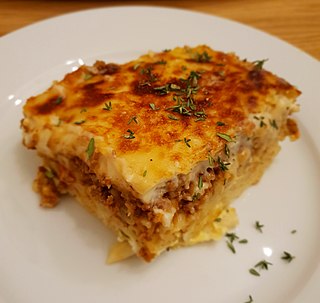
Pastitsio is a Greek baked pasta dish with ground meat and béchamel sauce, with variations of the dish found in other countries of the Mediterranean Sea.

Cannelloni are a cylindrical type of egg-based stuffed pasta generally served baked with a filling and covered by a sauce in Italian cuisine. Popular stuffings include spinach and ricotta or minced beef. The shells are then typically covered with tomato sauce.

Bucatini, also known as perciatelli, is a thick spaghetti-like pasta with a hole running through the center. It is common throughout Lazio, particularly Rome.

Orzo, also known as risoni, is a form of short-cut pasta shaped like a large grain of rice. Orzo is traditionally made from flour, but it can also be made of whole grain. It is often made with semolina, a type of flour made from durum wheat.

Rigatoni are a type of pasta. They are larger than penne and ziti, and sometimes slightly curved, but not as curved as elbow macaroni. Rigatoni are characterized by ridges along their length, sometimes spiraling around the tube; unlike penne, the ends of rigatoni are cut perpendicular to the tube walls instead of diagonally.

Pasta e fagioli is a traditional Italian pasta soup of which there are several regional variants.

Pasta salad, known in Italian as insalata di pasta or pasta fredda, is a salad dish prepared with one or more types of pasta, almost always chilled or room temperature, and most often tossed in a vinegar, oil, or mayonnaise-based dressing. It is typically served as an appetiser (antipasto) or first course. Pasta salad is often regarded as a spring or summertime dish, but it can be served any time of year.
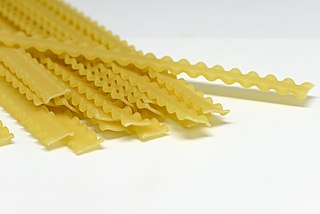
Mafaldine, also known as reginette or simply mafalda or mafalde, is a type of ribbon-shaped pasta.

Pastina is a variety of pasta consisting of tiny pieces, typically of a round (irregular) shape with a diameter of about 1.6 millimetres (1/16"). It is the smallest type of pasta produced. It is made of wheat flour and may also include egg. Pastina is a general term referring to many small shapes of pasta. Pastina is used in many different ways in Italian cuisine, including as an ingredient of soup, desserts, infant food and also, alone, as a distinct and unique pasta dish.

Sacchettoni is a type of stuffed pasta also known as "beggar's purse". It consists of small circles or squares of pasta filled like ravioli then fastened at the top like a small bag.
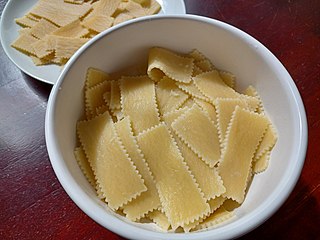
Sagnarelli are a type of ribbon pasta originating in the Abruzzo region of Italy. They are typically rectangular ribbons with fluted edges. Sagnarelli are usually served with a cream sauce and their sometimes uneven texture helps to hold thick sauces better.
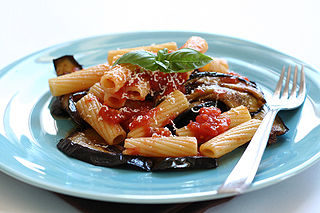
Pasta alla Norma, earlier called pasta con le melanzane, is an Italian dish of pasta and eggplant. It is typical of Sicilian cuisine, from Catania in particular.
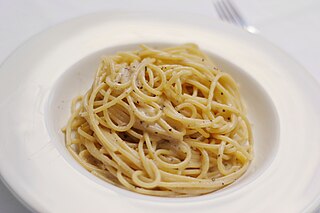
Cacio e pepe is a pasta dish typical of the Lazio region of Italy. Cacio e pepe means 'cheese and pepper' in several central Italian dialects. In keeping with its name, the dish contains grated pecorino romano and black pepper, together with tonnarelli or spaghetti. The origins of the dish are believed to be that "Shepherds from the pastoral communities of Lazio, Abruzzo, Tuscany and Umbria created cacio e pepe in the 18th or 19th century." All the ingredients keep well for a long time, which made the dish practical for shepherds without fixed abode. Rough-surfaced pasta is recommended to make the sauce adhere well.


















